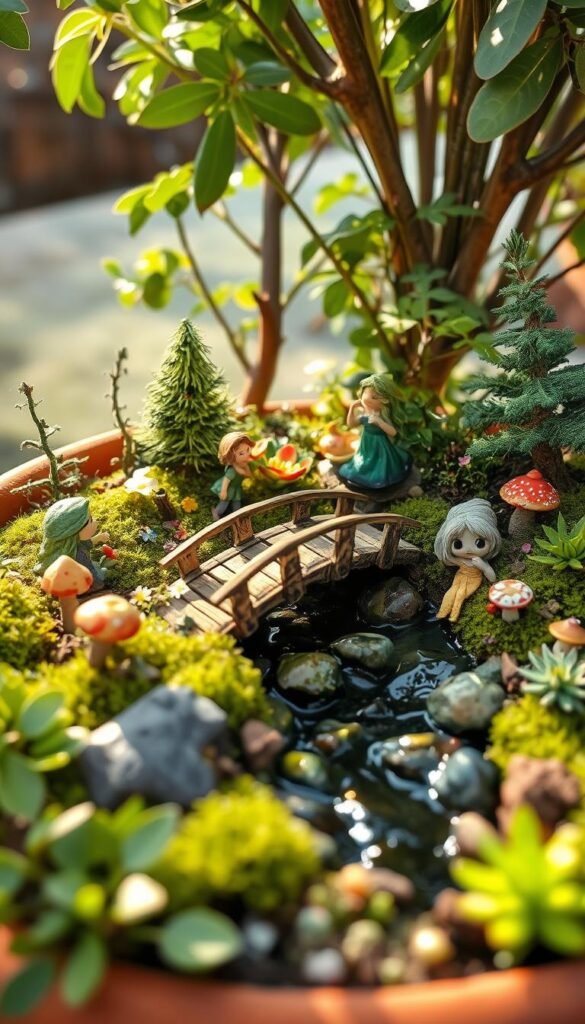Step into a world where imagination grows wild and tiny wonders thrive. Miniature landscapes filled with whimsical characters and lush greenery have become beloved additions to homes across the U.S. These enchanted creations blend gardening with storytelling, offering a unique way to connect with nature—even in the coziest corners.
Perfect for balconies, windowsills, or tabletops, these tiny ecosystems let you craft magic through mini plants and playful accents. Whether you’re nurturing succulents in a teacup or designing a woodland scene in a planter, the process invites creativity while teaching basic horticultural skills. Studies show that tending to plants reduces stress, making these projects ideal for busy adults and curious kids alike.
Families love how these gardens spark imagination and responsibility in children. Small hands learn to care for living things while arranging colorful containers and natural decorations. For adults, arranging mossy pathways or tiny furniture becomes a mindful escape—a chance to slow down and shape beauty in palm-sized spaces.
Ready to transform ordinary pots into extraordinary realms? Let’s explore how compact designs can deliver big joy, blending artistry with nature’s simplicity.
Getting Started with Your Enchanted Fairy Garden
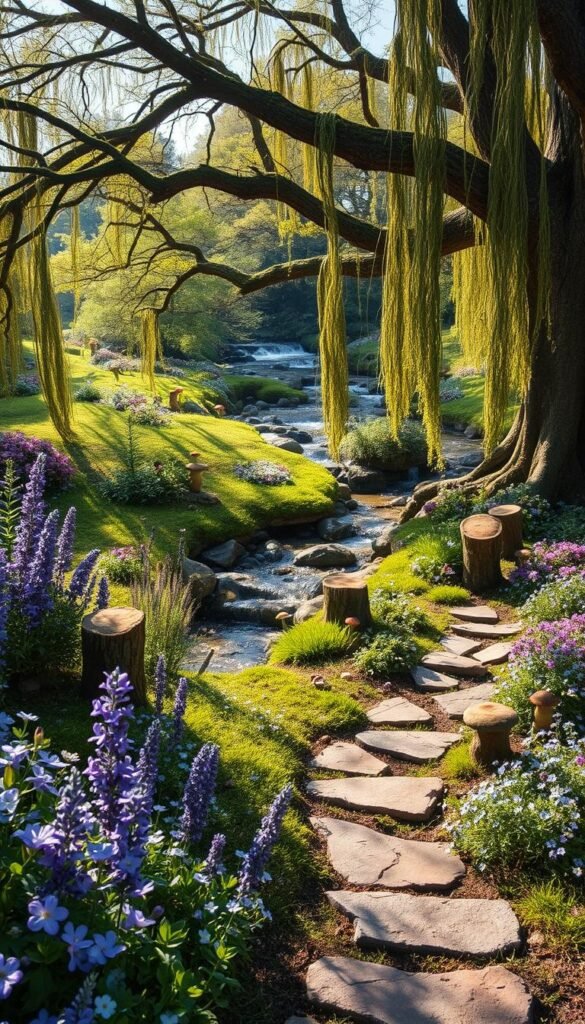
Unlock creativity by transforming ordinary containers into storytelling landscapes. These miniature ecosystems blend gardening with fantasy, letting you craft scenes that spark joy in tight spaces. Whether designing for relaxation or play, every choice—from theme selection to plant placement—builds a tiny universe brimming with personality.
Why Mini Worlds Matter
Fairy gardens aren’t just pretty decorations. They’re interactive spaces where kids learn responsibility through plant care, while adults find stress relief in arranging tiny details. Studies show tactile activities like arranging pebble paths or mossy hills improve focus and calmness.
Crafting Your Vision
Start by choosing a theme that fits your space and lighting. A sunny windowsill? Try a desert oasis with succulents. Shady corner? Build a fern-filled woodland retreat. Use this table to match ideas with your conditions:
| Theme | Key Elements | Ideal Plants |
|---|---|---|
| Beach Paradise | Sand, shells, driftwood | Sedum, air plants |
| Enchanted Forest | Mushrooms, bark, moss | Irish moss, baby tears |
| Mountain Camp | Pebbles, tiny tents | Dwarf conifers, thyme |
For more inspiration, discover creative fairy garden ideas that turn limitations into advantages. Remember: your theme can evolve. Add movable figurines today, swap them tomorrow—your tiny realm grows as your imagination does.
Selecting the Ideal Pot and Soil
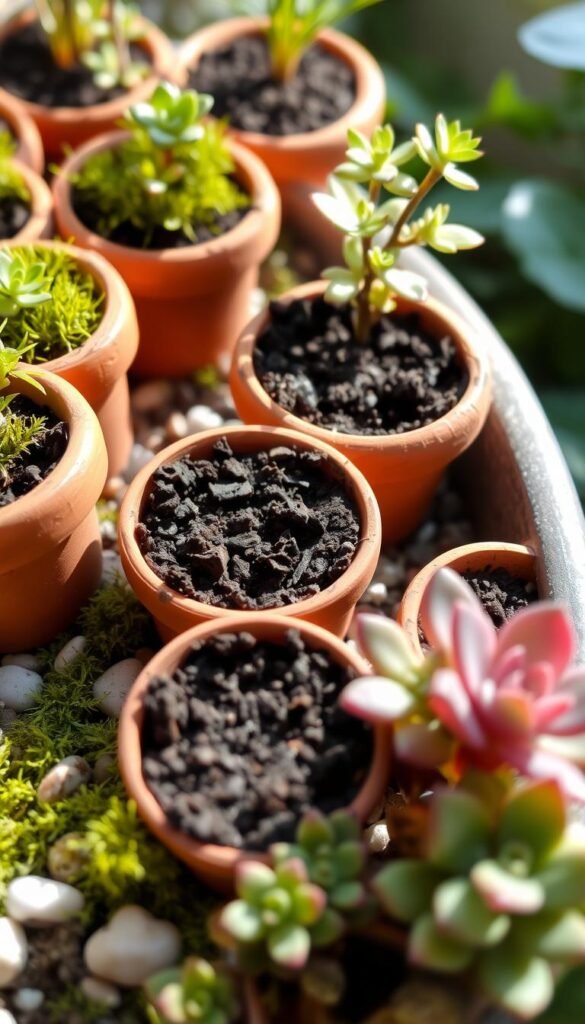
The foundation of every enchanting scene lies in its vessel and earth. Whether reviving cracked ceramics or upcycling thrifted treasures, your container choice shapes both aesthetics and plant health. Drainage matters most—without proper water flow, even the most magical designs turn into soggy disasters.
Containers That Breathe
Look for pots with holes at the bottom. No drainage? Drill 1-2 small openings using a masonry bit. This table shows creative solutions:
| Container Type | Drainage Solution | Best For |
|---|---|---|
| Terra cotta | Natural evaporation | Succulents |
| Teacups | Layer pebbles below soil | Small ferns |
| Broken pots | Use intact sections | Moss gardens |
Soil Science Simplified
Match your dirt to plant needs. Succulents demand gritty cactus mix, while leafy greens thrive in organic potting soil. Enrich standard blends with:
- Worm castings for nutrients
- Peat moss for moisture control
- Perlite for air pockets
One gardener’s tip rings true: Healthy roots mean happy shoots.
Test your soil’s drainage by watering it—if puddles form after 10 seconds, add more sand or gravel.
Gathering Essential Materials and Supplies
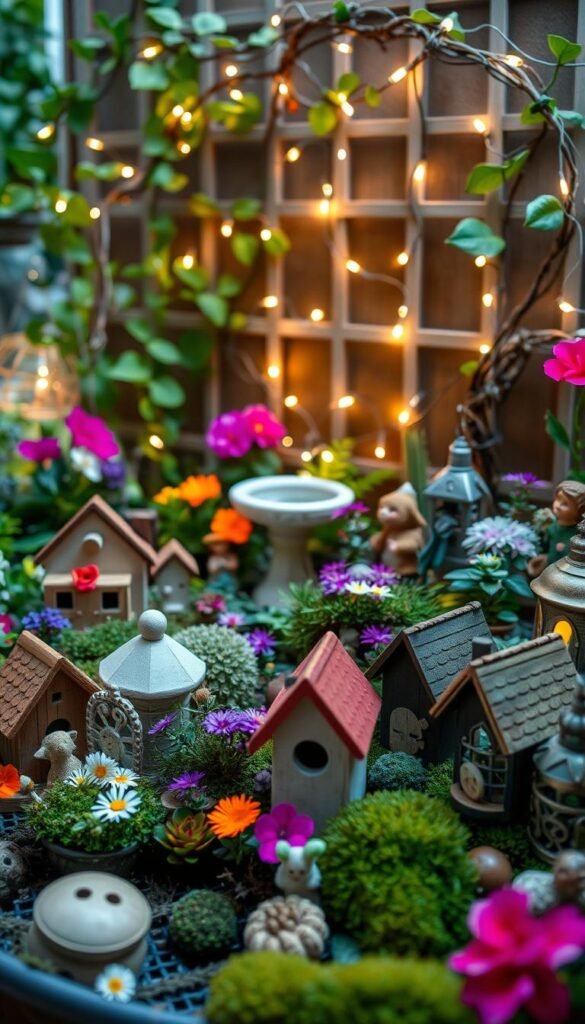
The right supplies transform ordinary pots into magical scenes. Before building, gather your tools and decorative elements. This ensures smooth creation and lets you focus on design details.
Tools You’ll Need
Start with these essentials for shaping your tiny world:
| Tool | Purpose | Pro Tip |
|---|---|---|
| Mini shovel | Soil placement | Use terrarium sets for tight spaces |
| Pruning shears | Plant trimming | Cut at 45° angles |
| Long tweezers | Precise decorating | Rubber tips prevent scratches |
| Paintbrushes | Debris removal | Keep sizes 00-4 handy |
Small plastic containers help organize stones and soil types. Garden gloves protect hands during messy work.
Miniatures, Accessories, and Decorative Items
Mix store-bought charm with natural finds. Try this balance:
| Source | Materials | Budget Tip |
|---|---|---|
| Craft stores | Resin houses | Wait for 40% coupons |
| Nature walks | Pine cones, bark | Bake finds to kill bugs |
| Home projects | Popsicle sticks | Seal with outdoor Mod Podge |
Twine-wrapped sticks make great fences. Sea glass adds watery sparkle. Dollar stores offer cheap marbles and tiles for pathways.
Plant Selection for Your Miniature Garden
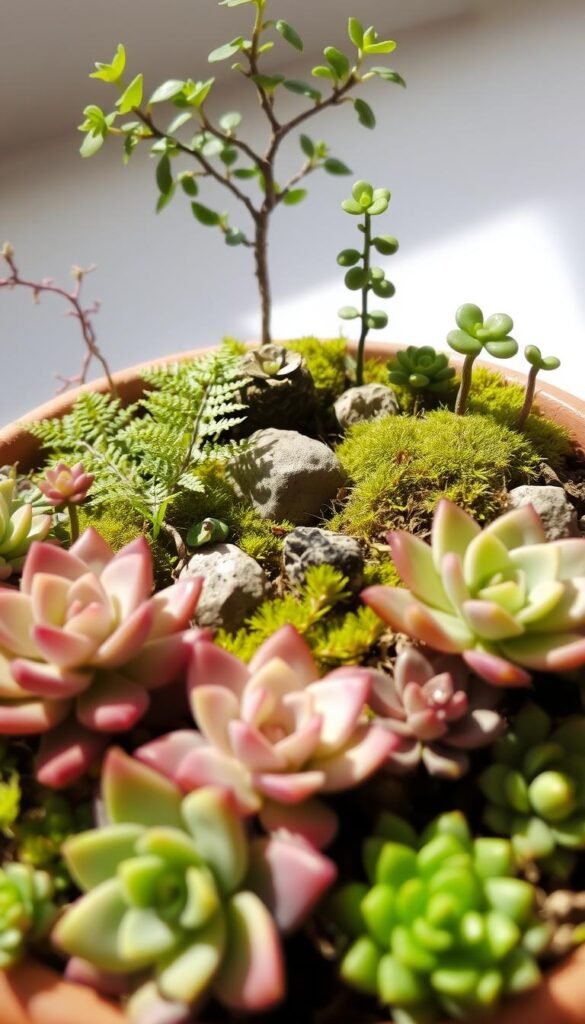
Choosing the right greenery turns your tiny landscape into a living masterpiece. Plants act as both scenery and storytellers, shaping your garden’s personality while thriving in limited space. Start by observing your sunlight patterns and local weather—these factors determine which varieties will flourish.
Drought-Friendly Stars
Sun-drenched spaces shine with water-wise succulents. Hens-and-chicks form rosette clusters resembling blooming flowers, while string of pearls adds cascading texture. For bold shapes, try echeveria’s rose-like formations or sempervivum’s spiky charm. These low-maintenance options thrive with minimal care:
- Ice plant: Colorful ground cover
- Sedum: Varied textures
- Aloe hybrids: Architectural appeal
Climate-Adaptive Alternatives
Humid areas demand different strategies. Irish moss creates velvety lawns in shady spots, while creeping thyme releases fragrance underfoot. Consider these moisture-loving picks:
| Condition | Solutions | Features |
|---|---|---|
| Shade | Baby tears | Delicate foliage |
| Partial sun | Miniature daisies | Cheerful blooms |
| Indoor | African violets | Year-round color |
Always check mature sizes—dwarf varieties like micro clover stay compact. Mix leaf textures and bloom cycles for continuous visual interest. Local nurseries often stock region-specific small plants perfect for container life.
How to Make a Fairy Garden in a Pot for a Small Space

Transform your container into a living storybook with these six essential steps. Begin by filling three-quarters of your pot with well-draining soil—mix in gravel or perlite if using standard potting mix. This creates a stable base while preventing waterlogged roots. Clay-rich dirt works best for shaping slopes and securing structural elements.
Elevate your design by stacking broken pottery shards or smooth river rocks. Press them firmly into the soil, building terraces that maximize vertical space. For connecting levels, place flat stones as stairs, angling them slightly for natural-looking transitions. Let the structure dry overnight before planting.
Position your largest plant first—like a dwarf conifer or rosette succulent—as the focal point. Surround it with smaller varieties, leaving breathing room for growth. Container gardening basics apply here: deeper roots go toward the center, trailing plants near edges.
Define walkways using coarse sand or crushed shells, smoothing surfaces with a small paintbrush. Add character with pebble borders or miniature signs. Finally, place fairy-sized accessories where they tell a story—a tiny bench under leafy foliage or a ceramic pond beside mossy banks.
Step back frequently to assess balance. Rotate the pot, adjusting elements until every angle feels magical. Your finished creation proves that gardening artistry thrives even in compact settings.
Designing Multi-Level Garden Structures
Elevate your miniature world by crafting layered landscapes that captivate the eye. Multi-level designs add depth and drama to compact spaces, turning simple pots into dynamic storytelling stages. By working vertically, you create room for winding paths, hidden nooks, and tiered plant displays.
Building Supports and Creating Stairs
Stack broken pottery shards or river rocks to form sturdy retaining walls. Press clay-rich soil between layers for stability—this earthy “glue” hardens as it dries. Use flat stones as stair treads, angling them slightly upward for natural-looking transitions between tiers.
Using Natural Elements to Enhance Structure
Twisted sticks become rustic ladders or trellises when secured with waterproof glue. Scatter pebbles along pathways to define borders, and place colorful moss patches between rocks for pops of emerald green. For seasonal flair, tuck blooming DIY garden art pieces among the foliage.
Remember: odd numbers of elements (3 stones, 5 sticks) create visual harmony. Let your design evolve as plants grow—adjust placements to maintain balance while celebrating nature’s lively imperfections.

